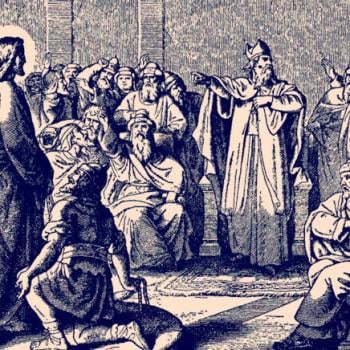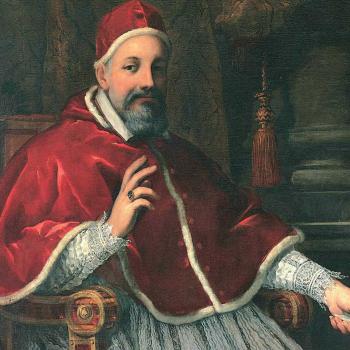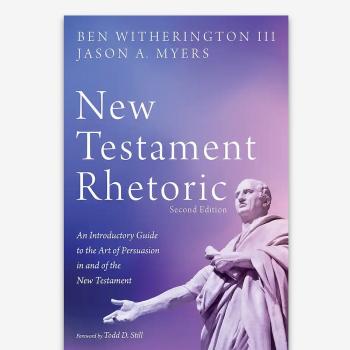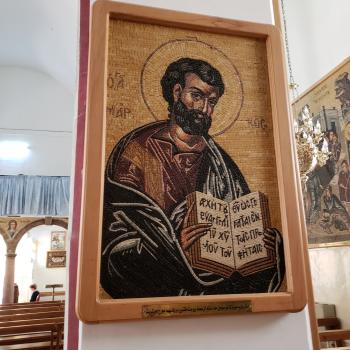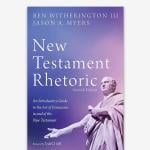Chapter Nine (pp. 287-318) is called Two Milestones on Jesus’ Way, but in some ways I suppose one could call them two millstones in Jesus’ way—- one is the partial confession of Peter at Caesarea Philippi the other the Transfiguration, which Peter didn’t entirely understand either. Right out of the box, the Pope offers the interesting observation that Banias, the shrine of the Greek god Pan, was in fact set up by Herod the Great, and later changed by his son into Caesarea Philippi. Banias, among other things, was thought to be the source of the Jordan river, but whether Herod the Great would set up such a pagan shrine is a question. Herod may have been part Jewish and part Idumean, and he may well have aped Greek and Roman building culture, but whether he would set up pagan shrines on the border of Israel is another question. It would appear to me more likely that this shrine was much earlier and from the Hellenistic age.
As the Pope points out, the Caesarea Philippi story reminds us that even after all the miracles and teaching, the most the people could come up with about Jesus was that he was a great prophet like John or Elijah or Jeremiah. The Elijah correlation was especially apt since he was a northern prophet who performed miracles and didn’t like the ruler in the land. The Pope rightly rejects theories which suggest that Jesus rejected the confession of Peter. Rather, he commended it, but he qualified it with a Son of Man. The command to silence had to do with Jesus wanting to define himself in his own terms in public. As the Pope adds it is the confession plus Jesus’ response that provides us with the full Christian confession (p. 298)— it has both an ontological and a salvation historical component. More should have been said however about the title Son of Man.
The Pope stresses that what was really offensive about Jesus’ claims was not that he was some sort of messianic or even political figure, but that he was claiming to be equal with God, or even to be the revelation of God on earth. Here again the Pope points to the accuracy of Jacob Neusner’s analysis of why Jews could only follow Jesus so far, and it didn’t have to do with his messianism.
The Transfiguration is linked by the Pope to the Caesarea episode, because it provides for the inner circle a further confirmation of the identity of Jesus, a divine confirmation this time. On p. 306 the Pope suggests that if the Transfiguration happened during the Feast of Booths, that it is possible to count backwards and see the Caesarea episode as happening on Yom Kippur, the Day of atonement, which could explain Jesus’ reference to his coming death. This idea is worth pondering. The Pope discusses the possibility that Exodus 24.16 lies in the background of the Transfiguration (the story of Moses on the mount with the glory cloud. The Pope contrasts Moses who merely reflects God’s glory, with Jesus who radiates it. The Pope is clear that Jesus saw John the Baptisr as the Elijah figure who had to come before him.
The Pope points out the theory that Exod. 33.14 and the establishment of the Tent of Meeting stands in the background of the Transfiguration story, but rejects it since the proposal is to set up three tents in our story, not one, as in Exodus (pp. 313-14). The Pope offers a theory that all the major Jewish Festivals contain three elements— a celebration originally borrowed from nature religion of creation and its bounty, a salvation historical celebration about God’s deeds in history, and a hope for definitive redemption in the future. So for example with the Feast of Tabernacles there is an association with prayers for rain, but also with the wilderness wandering existences of the Hebrews, and also with the future sukkoth where the just will dwell in the age to come under their vine and fig tree (see Lk. 16.9). The parallel with the Exodus story suggests that when the divine voice at the Transfiguration says ‘listen to him’ we should compare this to the Exodus story where it is Torah that is to be listened to. Jesus, is the final revelation from God. The Pope follows the lead of Rudolph Pesch who suggested that Mk. 9.1 is about the Transfiguration and seeing Jesus in glory on the mountain, not about the parousia, but rather a parousia preview. Jesus is the power of kingdom come. The parousia preview is also a revelation of the divine character of Jesus.





